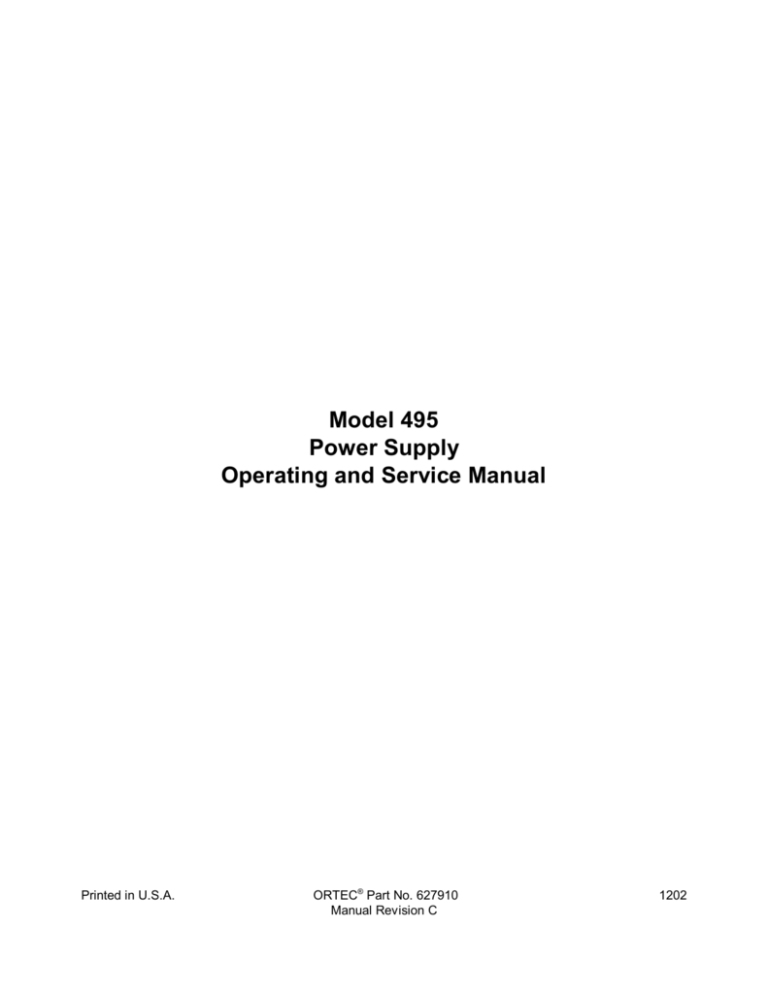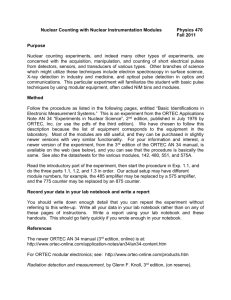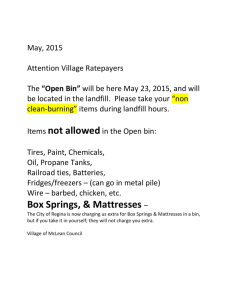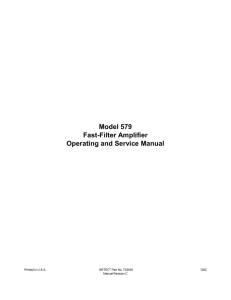
Model 495
Power Supply
Operating and Service Manual
Printed in U.S.A.
ORTEC® Part No. 627910
Manual Revision C
1202
Advanced Measurement Technology, Inc.
a/k/a/ ORTEC®, a subsidiary of AMETEK®, Inc.
WARRANTY
ORTEC* warrants that the items will be delivered free from defects in material or workmanship. ORTEC makes
no other warranties, express or implied, and specifically NO WARRANTY OF MERCHANTABILITY OR
FITNESS FOR A PARTICULAR PURPOSE.
ORTEC’s exclusive liability is limited to repairing or replacing at ORTEC’s option, items found by ORTEC to
be defective in workmanship or materials within one year from the date of delivery. ORTEC’s liability on any
claim of any kind, including negligence, loss, or damages arising out of, connected with, or from the performance
or breach thereof, or from the manufacture, sale, delivery, resale, repair, or use of any item or services covered
by this agreement or purchase order, shall in no case exceed the price allocable to the item or service furnished
or any part thereof that gives rise to the claim. In the event ORTEC fails to manufacture or deliver items called
for in this agreement or purchase order, ORTEC’s exclusive liability and buyer’s exclusive remedy shall be release
of the buyer from the obligation to pay the purchase price. In no event shall ORTEC be liable for special or
consequential damages.
Quality Control
Before being approved for shipment, each ORTEC instrument must pass a stringent set of quality control tests
designed to expose any flaws in materials or workmanship. Permanent records of these tests are maintained for
use in warranty repair and as a source of statistical information for design improvements.
Repair Service
If it becomes necessary to return this instrument for repair, it is essential that Customer Services be contacted in
advance of its return so that a Return Authorization Number can be assigned to the unit. Also, ORTEC must be
informed, either in writing, by telephone [(865) 482-4411] or by facsimile transmission [(865) 483-2133], of the
nature of the fault of the instrument being returned and of the model, serial, and revision ("Rev" on rear panel)
numbers. Failure to do so may cause unnecessary delays in getting the unit repaired. The ORTEC standard
procedure requires that instruments returned for repair pass the same quality control tests that are used for
new-production instruments. Instruments that are returned should be packed so that they will withstand normal
transit handling and must be shipped PREPAID via Air Parcel Post or United Parcel Service to the designated
ORTEC repair center. The address label and the package should include the Return Authorization Number
assigned. Instruments being returned that are damaged in transit due to inadequate packing will be repaired at the
sender's expense, and it will be the sender's responsibility to make claim with the shipper. Instruments not in
warranty should follow the same procedure and ORTEC will provide a quotation.
Damage in Transit
Shipments should be examined immediately upon receipt for evidence of external or concealed damage. The carrier
making delivery should be notified immediately of any such damage, since the carrier is normally liable for damage
in shipment. Packing materials, waybills, and other such documentation should be preserved in order to establish
claims. After such notification to the carrier, please notify ORTEC of the circumstances so that assistance can be
provided in making damage claims and in providing replacement equipment, if necessary.
Copyright © 2002, Advanced Measurement Technology, Inc. All rights reserved.
*ORTEC® is a registered trademark of Advanced Measurement Technology, Inc. All other trademarks used
herein are the property of their respective owners.
iii
CONTENTS
STANDARD WARRANTY . . . . . . . . . . . . . . . . . . . . . . . . . . . . . . . . . . . . . . . . . . . . . . . . . . . . . . . . . . . . . ii
SAFETY INSTRUCTIONS AND SYMBOLS . . . . . . . . . . . . . . . . . . . . . . . . . . . . . . . . . . . . . . . . . . . . . . . iv
SAFETY WARNINGS AND CLEANING INSTRUCTIONS . . . . . . . . . . . . . . . . . . . . . . . . . . . . . . . . . . . . . v
1. DESCRIPTION . . . . . . . . . . . . . . . . . . . . . . . . . . . . . . . . . . . . . . . . . . . . . . . . . . . . . . . . . . . . . . . . . . . 1
2. SPECIFICATIONS . . . . . . . . . . . . . . . . . . . . . . . . . . . . . . . . . . . . . . . . . . . . . . . . . . . . . . . . . . . . . . . .
2.1. PERFORMANCE . . . . . . . . . . . . . . . . . . . . . . . . . . . . . . . . . . . . . . . . . . . . . . . . . . . . . . . . . . . . .
2.2. CONTROLS . . . . . . . . . . . . . . . . . . . . . . . . . . . . . . . . . . . . . . . . . . . . . . . . . . . . . . . . . . . . . . . . .
2.3. MECHANICAL . . . . . . . . . . . . . . . . . . . . . . . . . . . . . . . . . . . . . . . . . . . . . . . . . . . . . . . . . . . . . . .
1
1
1
2
3. INSTALLATION . . . . . . . . . . . . . . . . . . . . . . . . . . . . . . . . . . . . . . . . . . . . . . . . . . . . . . . . . . . . . . . . . .
3.1. GENERAL . . . . . . . . . . . . . . . . . . . . . . . . . . . . . . . . . . . . . . . . . . . . . . . . . . . . . . . . . . . . . . . . . . .
3.2. OUTPUT POLARITY SELECTION . . . . . . . . . . . . . . . . . . . . . . . . . . . . . . . . . . . . . . . . . . . . . . . .
3.3. NIMBIN WIRING CHECK . . . . . . . . . . . . . . . . . . . . . . . . . . . . . . . . . . . . . . . . . . . . . . . . . . . . . . .
3.4. INSTALLATION IN NIMBIN . . . . . . . . . . . . . . . . . . . . . . . . . . . . . . . . . . . . . . . . . . . . . . . . . . . . .
2
2
2
2
3
4. OPERATION . . . . . . . . . . . . . . . . . . . . . . . . . . . . . . . . . . . . . . . . . . . . . . . . . . . . . . . . . . . . . . . . . . . . 3
4.1. NORMAL OPERATION . . . . . . . . . . . . . . . . . . . . . . . . . . . . . . . . . . . . . . . . . . . . . . . . . . . . . . . . 3
4.2. RESTORATION AFTER AUTOMATIC SHUTDOWN . . . . . . . . . . . . . . . . . . . . . . . . . . . . . . . . . . 3
5. MAINTENANCE AND TESTING . . . . . . . . . . . . . . . . . . . . . . . . . . . . . . . . . . . . . . . . . . . . . . . . . . . . . .
5.1. TEST EQUIPMENT REQUIRED . . . . . . . . . . . . . . . . . . . . . . . . . . . . . . . . . . . . . . . . . . . . . . . . .
5.2. PERFORMANCE TESTS . . . . . . . . . . . . . . . . . . . . . . . . . . . . . . . . . . . . . . . . . . . . . . . . . . . . . . .
5.3. TROUBLESHOOTING SUGGESTIONS . . . . . . . . . . . . . . . . . . . . . . . . . . . . . . . . . . . . . . . . . . .
5.4. FACTORY REPAIR SERVICE . . . . . . . . . . . . . . . . . . . . . . . . . . . . . . . . . . . . . . . . . . . . . . . . . . .
3
3
3
4
4
iv
SAFETY INSTRUCTIONS AND SYMBOLS
This manual contains up to three levels of safety instructions that must be observed in order to avoid
personal injury and/or damage to equipment or other property. These are:
DANGER
Indicates a hazard that could result in death or serious bodily harm if the safety instruction is
not observed.
WARNING
Indicates a hazard that could result in bodily harm if the safety instruction is not observed.
CAUTION
Indicates a hazard that could result in property damage if the safety instruction is not
observed.
Please read all safety instructions carefully and make sure you understand them fully before attempting to
use this product.
In addition, the following symbol may appear on the product:
ATTENTION – Refer to Manual
DANGER – High Voltage
Please read all safety instructions carefully and make sure you understand them fully before attempting to
use this product.
v
SAFETY WARNINGS AND CLEANING INSTRUCTIONS
DANGER
Opening the cover of this instrument is likely to expose dangerous voltages. Disconnect the
instrument from all voltage sources while it is being opened.
WARNING Using this instrument in a manner not specified by the manufacturer may impair the
protection provided by the instrument.
Cleaning Instructions
To clean the instrument exterior:
! Unplug the instrument from the ac power supply.
! Remove loose dust on the outside of the instrument with a lint-free cloth.
! Remove remaining dirt with a lint-free cloth dampened in a general-purpose detergent and water
solution. Do not use abrasive cleaners.
CAUTION To prevent moisture inside of the instrument during external cleaning, use only enough liquid
to dampen the cloth or applicator.
!
Allow the instrument to dry completely before reconnecting it to the power source.
vi
1
ORTEC MODEL 495
POWER SUPPLY
1. DESCRIPTION
The ORTEC Model 495 Power Supply is a singlewidth NIM module that can be installed in any NIM
Bin to provide either +6V or !6V dc through the
distribution bus in the bin. Its intended use is as an
addition to NIM Bins that are not equipped with 6V
dc bin power.
Either polarity is preselected in the Model 495
before it is inserted into the bin. A set of four
jumpers on the printed wiring board, (PWB), provide
for polarity selection. No other adjustments or
controls are required, and the Model 495 is turned
on automatically when the main bin power is
plugged in and turned on.
The internal circuit is adjusted at the factory to
provide the 6 V dc level and to furnish it to the
proper connector pins of the remaining module
positions in the bin. The level can be adjusted, if
desired, within a range of ~4.5 V through 6.8 V by
using a front panel screwdriver control. The
selected polarity is shown by a front panel LED, and
the voltage level can be monitored (or used
externally) at front panel test points.
If the Model 495 is installed in a bin which already
has +6 V and !6 V available from its power supply,
no damage will be incurred, but both front panel
LED lights will be turned on because both polarities
of 6 V dc power are available on the distribution
bus.
2. SPECIFICATIONS
OUTPUTS +6 V or !6 V at 0 to 6 A. Polarity
jumper-selectable; output level adjustable.
PROTECTION
Overvoltage Latching crowbar shorts output and
maintains zero output if output level exceeds
crowbar sensitivity of 6.8 ± 0.5 V.
Short Circuit and Overload Accomplished with
automatic recovery after a fault has been removed.
Input Circuits Include an input line filter and a 1A fuse.
REGULATION AND INSTABILITY <±0.1% for
specified line and load ranges.
TURN ON, TURN OF TRANSIENTS
nominal output.
2.1. PERFORMANCE
INPUT 103 to 130 V ac, 47 to 63 Hz; 0.80 A
maximum current.
TYPICAL EFFICIENCY 70%.
OPERATING TEMPERATURE RANGE 0 to +60°C
(32 to 140°C).
TEMPERATURE COEFFICIENT ±200 ppm/°C
maximum.
NOISE AND RIPPLE
MHz bandwidth.
<30 mV peak-to peak 20
S for f < 100 kHz.
OUTPUT IMPEDANCE <0.12
RECOVERY TIME <3 ms to within ±1% after noload to full-load change.
<5% of
2.2. CONTROLS
POLARITY SELECTION
A set of four internal
jumpers must all be set to select either positive or
negative output polarity before the Model 495 is
installed in the bin.
ADJUST A front panel screwdriver control permits
the output dc level to be adjusted within the range
of ~4.5 V to the overvoltage crowbar sensitivity
level (nominal 6.8 V ).
2
2.3. MECHANICAL
WEIGHT
Net 1.2 kg (2.7 lb).
Shipping 2.7 kg (6.1 lb).
DIMENSIONS NIM-standard single-width module,
3.43 X 22.13 cm (1.35 X 8.714 in.) Per TID-20893
(Rev).
3. INSTALLATION
3.1. GENERAL
The ORTEC 495 Power Supply is normally used
in conjunction with other modular electronics and
is installed in a standard bin and power supply
such as the ORTEC 4001A/4002A. The bin and
power can be rack-mounted together with other
equipment. Therefore, any other equipment that
may be installed in the same rack must be
sufficiently cooled by circulating air to prevent any
localized heating in the 495 circuits. The
temperature of equipment installed in racks can
easily exceed 60°C (140°F) unless precautions
are taken to prevent this from happening, and the
495 circuits may be damaged if they are exposed
to such heat levels.
3.2. OUTPUT POLARITY SELECTION
WARNING
Insure that all four jumpers are set properly.
Damage will result to the instrument if all four
jumpers are not set to the same polarity.
The output polarity of the 495 is determined by
the setting of two pairs of jumpers, W1 and W2,
on the PWB. Access to the jumper locations is
obtained by removing the left side panel of the
module (viewed from the front). The two alternate
locations for each of the four jumpers are marked
on the left side panel.
WARNING
Return the side panel and secure it in place
before placing the 495 in a bin for operation;
potentially lethal voltage is present on the
surface of the PWB when power is supplied
to the module.
3.3. NIMBIN WIRING CHECK
The NIMBIN designated for mating with the 495
should be checked for proper wiring before
installing the 495. Follow the procedure given
below, starting with the NIMBIN power Off.
1. Using an ohmmeter, check for continuity
between the NIMBIN front panel +6 V test
point and pin 10 of every module connector on
the NIMBIN.
2. Similarly, check for continuity between the
NIMBIN front panel -6 V test point and pin 11
of every module connector on the NIMBIN.
3. Turn on the NIMBIN power switch with the 495
not yet installed.
4. Using a dc-voltmeter, check for 0 V at the
NIMBIN front panel +6 V and -6 V test points.
5. Turn Off the NIMBIN power switch.
6. Should any test result differ from the above
description, contact ORTEC Customer
Service at 865/483-2231 or your local affiliate.
3.4. INSTALLATION IN NIMBIN
The 495 can be installed in any unoccupied
module position in any standard NIMBIN. When it
has been installed properly, it will be turned on
automatically when ac power is turned on to the
bin and power supply, and the generated dc level
is provided through the rear panel connector into
the bin distribution circuit. If the 495 output
polarity has been set for positive voltage, the
output is provided to pin 10 of the bin distribution
bus. If the polarity is negative, the output is
provided to the pin 11 bus. Ground for either
output polarity is provided through the pin 34 bus.
3
If a voltage source is required for some external
application other than to modules in the bin, pin
plugs may be inserted into the front panel test
jacks on the 495 to obtain this external dc level.
Note that only one polarity is available, as
indicated by the LEDs, unless both polarities are
present in the bin distribution circuit.
In the event that both positive and negative
polarities are desired and are to be furnished from
495 power supplies, two 495 modules can be
installed in the same bin, with one set for positive
output and the other for negative output. In this
case, both LEDs will light on both 495 modules
because both polarities are present in the bin.
4. OPERATION
4.1. NORMAL OPERATION
After checking both the polarity of the 495 and the
NIM-BIN wiring according to the information in
Section 3, insert it into any module location in the
bin which it is to serve. When power is turned on
for the bin power supply, the 495 is turned on
automatically. An LED on the front panel serves
as a monitor of the polarity that is being furnished
into the bin.
4.2. RESTORATION AFTER AUTOMATIC
SHUTDOWN
In the event of an overvoltage output condition,
an internal crowbar protection will automatically
short the output voltage to zero, and the front
panel monitor LED will turn off. This condition is
unlikely unless the front panel Adjust control has
been advanced to produce a higher voltage level.
If the condition should occur, simply turn off the
power to the bin power supply or pull the module
from its location in the bin to remove the ac input
voltage to the module. If appropriate, reduce the
setting of the Adjust control and apply ac power to
the module again. The generated voltage level
can be monitored at the front panel test points.
If the current demand from any load that is
imposed on the 6 V supply should exceed 6
amperes, an internal foldback circuit in the 495
will limit the current to the safe limit by lowering
the output voltage. The front panel monitor LED
will turn off to indicate this condition.
5. MAINTENANCE AND TESTING
CAUTION
Voltages are present in this instrument that are
hazardous. Do not attempt to operate the 495
power supply while the side cover is removed.
5.1. TEST EQUIPMENT REQUIRED
Nuclear Standard Bin and Power Supply such as
the ORTEC 4001A/4002A.
Oscilloscope with sensitivity of 5 mV/cm
Digital voltmeter
Schematic of the 495 power supply
5.2. PERFORMANCE TESTS
1. Install the 495 power supply in a bin and power
supply. Turn on power for the bin.
2. Observe the front panel LED indicators. Either
the +6 V or the -6 V LED should be lit to
indicate that an output is being generated.
NOTE: If the main bin and power supply
provides both of these levels, both LEDs will
light and the operation of the 495 cannot be
tested.
3. Measure the output voltage level at the front
panel test points using a digital voltmeter. If
desired, use a screwdriver to change the
setting of the front panel Adjust control.
4. An oscilloscope can be connected at the front
panel test points to check for ripple in the
output without interfering with operation of the
other modules that may also be installed in the
bin.
5.3. TROUBLESHOOTING SUGGESTIONS
1. Ensure that the proper ac input voltage is
being supplied to the 495. It requires a
nominal 117 V ac input through bin pins 33
and 41.
2. Check the ac input fuse on the rear panel of
the 495. Replace, if necessary, with a 1-A
fuse.
4
3. If the output voltage has exceeded the
crowbar trigger level, neither front panel LED
will light. To restore operation, remove the ac
power input from the 495 and then turn it on
again.
5.4. FACTORY REPAIR SERVICE
This instrument can be returned to the ORTEC
factory for service and repair at a nominal cost.
Our standard procedure for repair includes the
same quality control and checkout that are used
for a new instrument. Always contact the
Customer Service Department at ORTEC,
865/483-2231, before sending in an instrument for
repair.
5
Bin/Module Connector Pin Assignments
For Standard Nuclear Instrument Modules
per DOE/ER-0457T.
Pin
1
2
3
4
5
6
7
8
9
*10
*11
12
13
14
15
*16
*17
18
19
20
21
22
Function
+3 V
!3 V
Spare bus
Reserved bus
Coaxial
Coaxial
Coaxial
200 V dc
Spare
+6 V
!6 V
Reserved bus
Spare
Spare
Reserved
+12 V
!12 V
Spare bus
Reserved bus
Spare
Spare
Reserved
Pin
23
24
25
26
27
*28
*29
30
31
32
*33
*34
35
36
37
38
39
40
*41
*42
G
Function
Reserved
Reserved
Reserved
Spare
Spare
+24 V
!24 V
Spare bus
Spare
Spare
117 V ac (hot)
Power return ground
Reset (Scaler)
Gate
Reset (Auxiliary)
Coaxial
Coaxial
Coaxial
117 V ac (neutral)
High-quality ground
Ground guide pin
Pins marked (*) are installed and wired in
ORTEC’s 4001A and 4001C Modular System
Bins.









